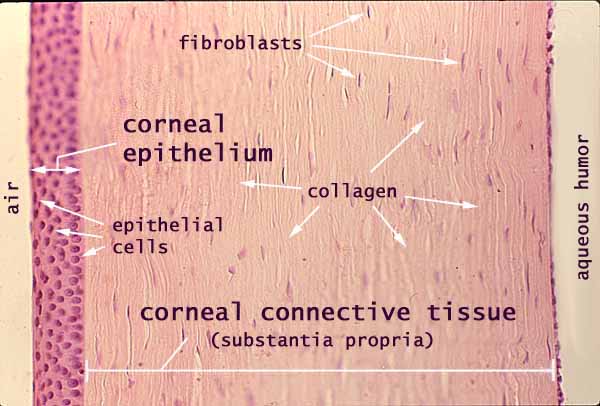

Cornea: epithelium and connective tissue

Dense fibrous connective tissue covered by nonkeratinized stratified squamous epithelium comprises the cornea.
This is perhaps the simplest presentation of connective tissue and epithelium in the body, lacking blood vessels and complex epithelial derivatives (in contrast with, e.g., skin).
In spite of its apparent simplicity, corneal tissues are also highly specialized for transparency and precise curvature.
Corneal connective tissue, also called corneal stroma or substantia propria, consists of numerous layers of collagen fibers embedded in a glycosaminoglycan ground substance. Collagen fibers are arranged into many layers parallel to the corneal surface. The fiber orientation alternates from layer to layer. Scattered within the substantia propria are the flattened fibroblasts which produce the collagen and ground substance.
Corneal epithelium consists of several (5 to 6) layers of cells. These cells are cuboidal through most of the thickness of the epithelium but become squamous (thin and flat) at the surface.
Note that epithelial tissue is classified according to the number of cell layers and the shape of surface cells, making this a stratified squamous epithelium.
Deep to the substantia propria, the single layer of low cuboidal cells adjacent to the aqueous humor is the so-called corneal endothelium. (This layer is unlabelled in the image.)
The cornea also displays two exceptionally thick basement membranes -- Bowman's membrane between the corneal epithelium and the substantia propria, and Descemet's membrane between the substantia propria and the corneal endothelium.
Comments and questions: dgking@siu.edu
SIUC / School
of Medicine / Anatomy / David
King
https://histology.siu.edu/intro/IN022b.htm
Last updated: 27 July 2023 / dgk